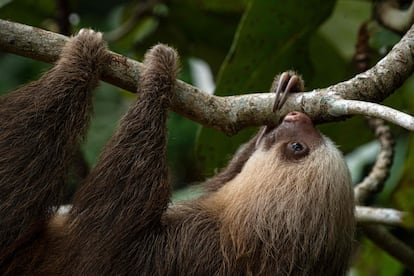Florida zoo welcomes furry baby Hoffman’s two-toed sloth
Wilbur, who was the last sloth born at the Palm Beach Zoo 21 years ago, and her mate Dustin are part of a professional scientific breeding program

An adorable, furry baby Hoffman’s two-toed sloth has made its debut at zoo in Florida. Zookeepers at the Palm Beach Zoo & Conservation Society have been monitoring the baby sloth and its mother, Wilbur, since witnessing the birth early in the morning of Jan. 23.
“This happened right in front of my eyes as we were on a 24-hour watch,” said Kelly Fad, the zoo’s general curator who also witnessed the birth. “The hanging mom literally scoops down and helps baby come up onto her body. She starts cleaning and the nursing started within just a couple of hours.”
Wilbur, who was the last sloth born at the Palm Beach Zoo 21 years ago, and her mate Dustin are part of a professional scientific breeding program called the Species Survival Plan. It manages the population of sloths in human care since their genetics may contribute to wild populations in the future, zoo officials said.
Fad says Wilbur and Dustin were matched in a way she compared to dating apps for humans. Turns out, they were a perfect match.
“We work with other zoos. There’s a keeper, species survival plan coordinator so that we can find the best genetic matches,” she said.
The goal is to “coordinate and work together so that we can help the conservation of these guys and have the best genetics and diversity possible in managed care.”
Male sloths do not play any part in the raising of babies, so Dustin remains in his original habitat at the zoo. Zoo officials are waiting to identify the baby sloth’s gender before deciding on a name.
“Gender is often a little bit hard to determine,” Fad said. “The mother’s name is Wilbur, which is typically more of a male name. And that’s because it’s not always easy to tell. So we like to give it a few weeks, and really be able to know for certain what the gender is before we start with the naming process.”
But the public is now welcome to visit the baby sloth. “We’re excited for guests to witness the development of this unique little baby,” said Renee Bumpus, Chief Animal Conservation Officer. “In the meantime, Wilbur is very attentive, and the baby will stay closely attached to mom for a while.”
Sign up for our weekly newsletter to get more English-language news coverage from EL PAÍS USA Edition
Tu suscripción se está usando en otro dispositivo
¿Quieres añadir otro usuario a tu suscripción?
Si continúas leyendo en este dispositivo, no se podrá leer en el otro.
FlechaTu suscripción se está usando en otro dispositivo y solo puedes acceder a EL PAÍS desde un dispositivo a la vez.
Si quieres compartir tu cuenta, cambia tu suscripción a la modalidad Premium, así podrás añadir otro usuario. Cada uno accederá con su propia cuenta de email, lo que os permitirá personalizar vuestra experiencia en EL PAÍS.
¿Tienes una suscripción de empresa? Accede aquí para contratar más cuentas.
En el caso de no saber quién está usando tu cuenta, te recomendamos cambiar tu contraseña aquí.
Si decides continuar compartiendo tu cuenta, este mensaje se mostrará en tu dispositivo y en el de la otra persona que está usando tu cuenta de forma indefinida, afectando a tu experiencia de lectura. Puedes consultar aquí los términos y condiciones de la suscripción digital.
More information
Archived In
Últimas noticias
Raúl Rocha, from jet-setting with Miss Universe to arms trafficking and fuel theft
80,000 barrels of Mexican oil sent to Cuba: Havana drawn into the US–Mexico clash
Human rights activists, opposition members, and a minor: Maduro’s other political prisoners
Israel sparks a civil war within the MAGA movement
Most viewed
- Reinhard Genzel, Nobel laureate in physics: ‘One-minute videos will never give you the truth’
- Pablo Escobar’s hippos: A serious environmental problem, 40 years on
- Charles Dubouloz, mountaineering star, retires at 36 with a farewell tour inspired by Walter Bonatti
- Why we lost the habit of sleeping in two segments and how that changed our sense of time
- The Florida Keys tourist paradise is besieged by immigration agents: ‘We’ve never seen anything like this’










































